In the great outdoors
ETH students are mapping the groundwater in an area of forest near Bern. This fieldwork will give them the skills they need for a career in environmental engineering.
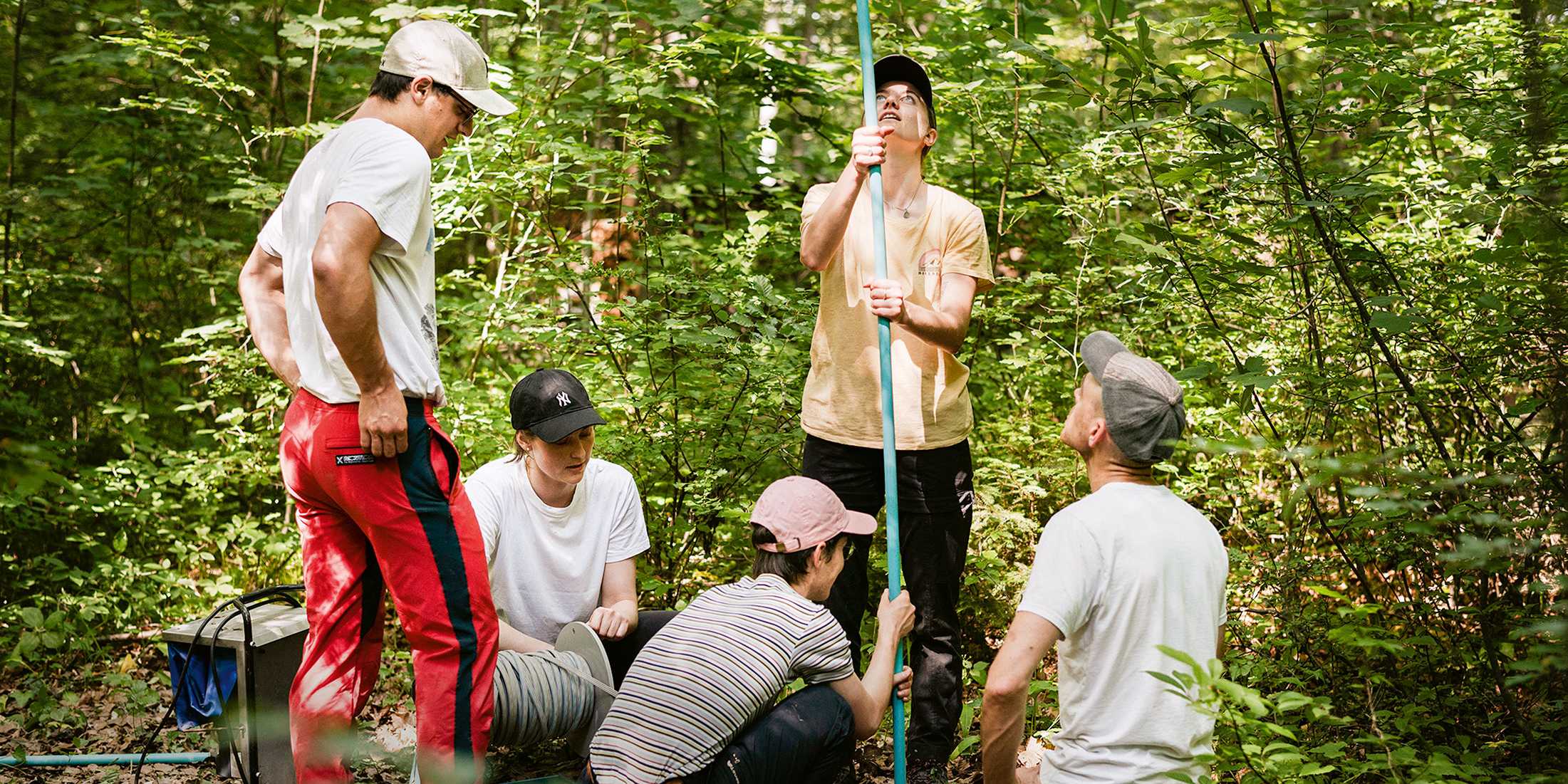
The meter emits a series of deafening beeps. Instinctively, everyone covers their ears. Without further ado, course co-leader Matthias Willmann pops the battery out of the device. Exchanging grins, the students continue to carefully lower the cable deeper into the borehole. Today’s task is to measure the quality of the groundwater here in Kappelen, a municipality in the canton of Bern.
It’s only been a few hours since Carole, Gianna, Raffaele and Robyn arrived. The four ETH students are here to complete a three-day module towards a Master’s degree in Environmental Engineering – a course offered by the ETH institute of the same name. Matthias Willmann has been coming to this area of forest for the past 15 years, initially as an ETH employee, recently as an external consultant. All in all, around 20 students are taking part in the module, which aims to map the local groundwater. Willmann has just explained to the group that there are 16 boreholes in the forest. Sunk vertically to over 10 metres, they are permeable below a certain depth. This provides an entry point for groundwater, which can then be analysed by the students.
The group’s first job is to measure the water table and the depth of each borehole. For this purpose, Willmann has brought two water-level meters from the equipment tent, which are similar in appearance to cable reels. In this case, however, the cable is a measuring tape attached not to a plug but rather to a thin metal rod – the measurement probe. He instructs the students to lower this carefully into the borehole. “As soon as the rod hits groundwater, current flows and the small display lamp will light up,” Willmann explains. Some models even feature an acoustic signal.
A feel for fieldwork
It doesn’t take long for the four Master’s students to get the hang of the meter. Initially, they work as a group. Raffaele slowly lowers the cable into the hole, with Carole lending a helping hand. The battery has been reinserted, and as soon as the lamp lights up and the device beeps, Robyn notes the reading on the tape. At borehole 3.1, the water table is at a depth of 3 metres and 95 centimetres. Gianna records the precise measurement. Raffaele then lowers the cable further until he detects slight resistance, which indicates the bottom of the borehole. “You develop a feeling for this,” says Willmann. Once again, Robyn records the reading.
Later, the four students will map the boreholes and plot the level of the water table. This will tell them in which direction the groundwater is flowing. Just like a river above ground, groundwater flows downhill. “The module gives students a feel for the reality of working in the field,” says Willmann. “The insights they get out here are really useful.” Joaquin Jimenez-Martinez, who co-leads the course with Willmann, nods in agreement.
Jimenez-Martinez works as a group leader at ETH Zurich and the Swiss Federal Institute of Aquatic Science and Technology (Eawag). He recently teamed up with ETH’s administrative department for Educational Development and Technology to take a closer look at the role of fieldwork. “The whole teaching process feels different when you have that connection to nature,” he explains. “As teachers, we give a quick introduction but then step back and let the students get on with it – taking measurements, trying stuff out, learning in the field.” He would love to explain the benefits in more detail, he says, but now he must dash for his train back to Zurich.
Meanwhile, the group is busy using a probe to measure groundwater temperature and conductivity. At a depth of 10 to 12 metres, the water has a temperature of 11 degrees Celsius – exactly as expected. The vertical hydraulic conductivity of the groundwater reveals certain details about its composition. Here in Kappelen, everything is as it should be. But an abnormal reading can also indicate the presence of contaminants. This would be a disaster for a country like Switzerland, where 80 percent of potable water is drawn from groundwater.
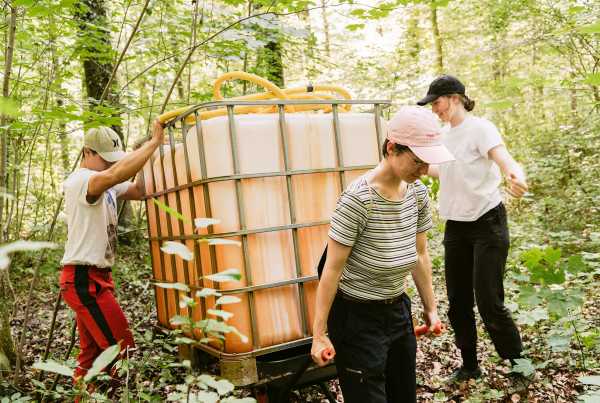 Theory first: Matthias Willmann (far left) explains the experiment to Robyn, Gianna, Carole and Raffaele (left to right).
Theory first: Matthias Willmann (far left) explains the experiment to Robyn, Gianna, Carole and Raffaele (left to right).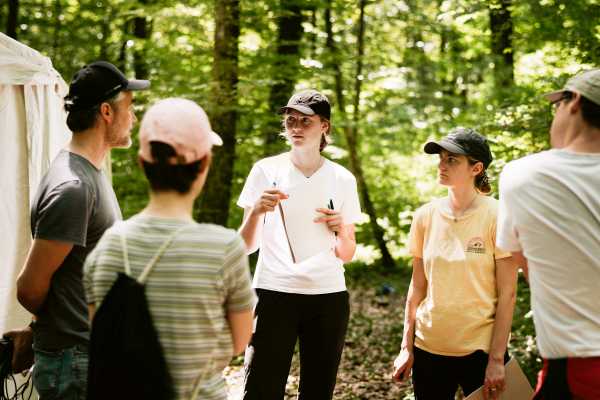 Measuring the water table in one of the boreholes.
Measuring the water table in one of the boreholes. Marius Floriancic (left) instructs students before the experiment in the forest.
Marius Floriancic (left) instructs students before the experiment in the forest.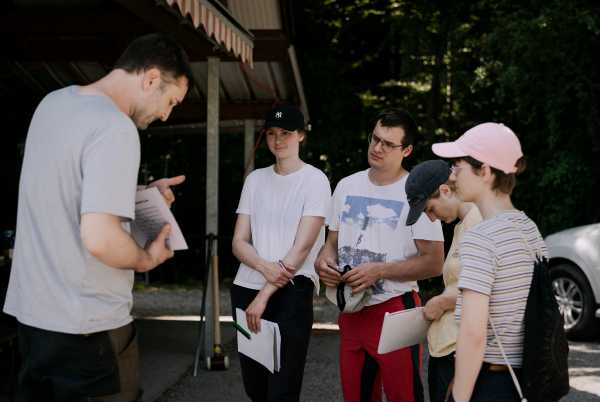 The four Master’s students make their way to the last experiment of the day. Later, they will spend the night under canvas.
The four Master’s students make their way to the last experiment of the day. Later, they will spend the night under canvas.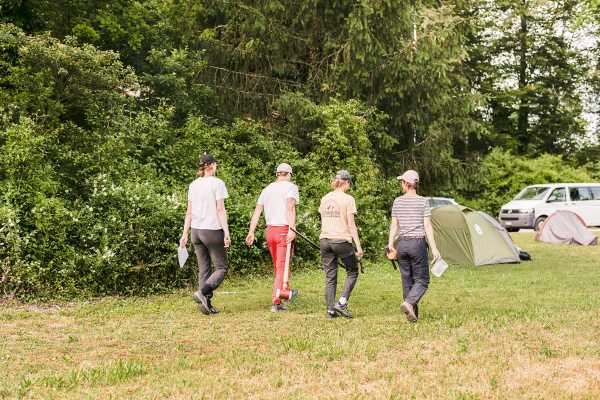
Big science
With the first experiment now completed, the students join Lucien Biolley, employee at ETH’s Institute of Environmental Engineering. Together with Marius Floriancic, he is responsible for ensuring that field instruments remain in perfect working order throughout the year. It’s also his job to prepare the equipment required for the present module: two vans and two fully packed trailers are dispatched each year from Hönggerberg campus to Kappelen. Biolley explains to the students how they can use a pressure sensor to continuously monitor the level of the water table. Inside the blue tubes that pass through the borehole caps are cables that transmit the measurements to a data box. This collates all the data and can also be accessed remotely from Zurich. Later on, the students will have a chance to crunch data collected over the past five years. Right now, however, there’s more immediate work to be done.
Carole, Gianna, Raffaele and Robyn use a wheelbarrow to fetch a 1,000-litre water tank – still empty, fortunately. They position it next to one of the boreholes and fill it with groundwater using a pump. That evening, marker dye will be added to the water to prepare it for another experiment. “The great thing about fieldwork is that everything’s on a big scale, including the equipment,” says Biolley. “That makes it much easier to figure out what’s going on.”
The four students are equally enthusiastic. Robyn and Carole completed a Bachelor’s in Environmental Sciences before switching to Environmental Engineering for their Master’s. “I’m interested in technical solutions to environmental issues,” Carole explains. “I like the hands-on approach.” And for Robyn, what counts is not only “what we learn while studying, but also the insight we get into environmental engineering as a profession.”
Forest or meadow?
For the next experiment, the students meet up with Marius Floriancic. His job is to teach them how to measure the amount of water the soil can hold. For this purpose, tensiometers are used. The students take the small tubes, fit a ceramic cap to the bottom and then fill them with water. The drier the soil, the greater the amount of water that passes though the ceramic cap and into the ground. The students insert the tubes to different depths in the forest floor. The readings show the water retention curve, a measure of the soil’s ability to absorb water.
A second instrument, shaped like a large fork, measures soil moisture. Floriancic asks where we think soil moisture will be higher: in the forest or in the open meadow? The answer is unanimous: the forest! To our great surprise, the measurements show the exact opposite. Together with the students, Floriancic explores the reasons why: when it rains, the tree canopy and natural debris on the forest floor prevent some of the water entering the soil; also, trees extract more moisture from the soil than grass does; and, finally, forest soil is more permeable than compact meadow soil, which means it lets through more water.
“Computing and modelling – that’s something ETH students are good at. But working out here in the field gives them a practical edge to that knowledge,” says Floriancic with a grin. “It’s an expensive module, but definitely worth the investment,” he adds, on a more serious note. As evening falls, the group returns to the water tank in the forest, where Biolley pours in the marker dye. The coloured water flows from the tank through a thick hose into one of the boreholes, where it mixes with the groundwater below. Some 30 metres away, groundwater is pumped to the surface from another borehole and fed through a monitoring device. It will take some time before any coloured water is detected.
The students have completed enough practical work for the day. Later on, they’ll be taking a closer look at the data on a laptop. It’s precisely this combination of field and desk work that Raffaele finds so rewarding. Gianna, who holds a scholarship from the ETH Excellence Scholarship & Opportunity Programme, also likes the variation. For her, it’s “the combination of technology and nature that makes environmental engineering so appealing”.
Fostering innovative teaching
As of May 2023, courses offered by the Laboratory for Environmental Engineering are being supported by the Innovedum Fund. In collaboration with the administrative department for Educational Development and Technology, a joint project is now underway to simplify the preliminary analysis of data. This will give students more time to devote to advanced data interpretation and the critical evaluation of measurement results. Innovative assessment methods, such as peer grading, also help hone critical thinking.
Globe What holds the world together
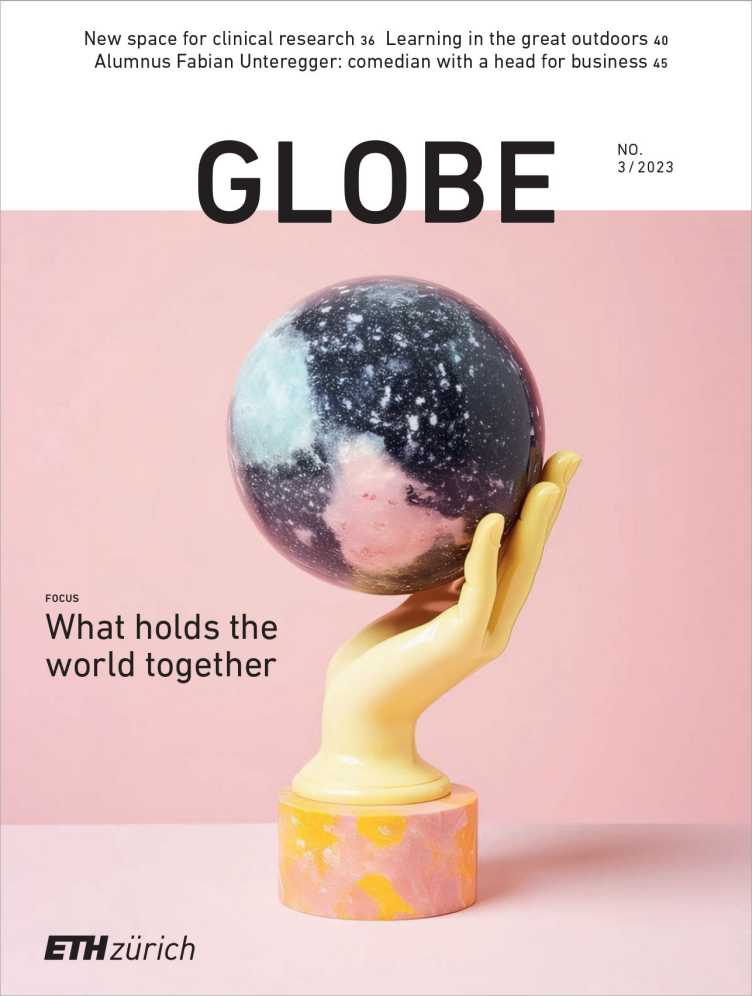
This text appeared in the 23/03 issue of the ETH magazine Globe.
DownloadRead whole issue (PDF, 4.6 MB)vertical_align_bottom
